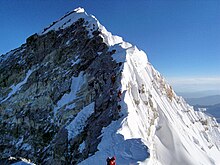|
Death zone In mountaineering, the death zone refers to altitudes above which the pressure of oxygen is insufficient to sustain human life for an extended time span. This point is generally agreed as 8,000 m (26,000 ft), where atmospheric pressure is less than 356 millibars (10.5 inHg; 5.16 psi).[1] The concept was conceived in 1953 by Edouard Wyss-Dunant, a Swiss doctor, who called it the lethal zone.[2] All 14 peaks above 8000 m (the "eight-thousanders") in the death zone are located in the Himalaya and Karakoram regions of Asia. Many deaths in high-altitude mountaineering have been caused by the effects of the death zone, either directly by the loss of vital functions or indirectly by poor decisions made under stress (e.g., not turning back in deteriorating conditions, or misreading the climbing route), or physical weakening leading to accidents (e.g., falls). An extended stay above 8,000 m (26,000 ft) without supplementary oxygen will result in deterioration of bodily functions and death.[3][4][5] Physiological backgroundThe human body has optimal endurance below 150 m (490 ft) elevation.[6] The concentration of oxygen (O2) in air is 20.9% so the partial pressure of O2 (PO2) at sea level is about 21.2 kPa (6.3 inHg; 3.07 psi). In healthy individuals, this saturates hemoglobin, the oxygen-binding red pigment in red blood cells.[7] Atmospheric pressure decreases with altitude while the O2 fraction remains constant to about 85 km (53 mi), so PO2 decreases with altitude as well. It is about half of its sea level value at 5,500 m (18,000 ft), the altitude of the Mount Everest base camp, and less than a third at 8,849 m (29,032 ft), the summit of Mount Everest.[8] When PO2 drops, the body responds with altitude acclimatization.[9] Additional red blood cells are manufactured; the heart beats faster; non-essential body functions are suppressed, food digestion efficiency declines (as the body suppresses the digestive system in favor of increasing its cardiopulmonary reserves);[10] and one breathes more deeply and more frequently. But acclimatization requires days or even weeks. Failure to acclimatize may result in altitude sickness, including high-altitude pulmonary edema (HAPE) or cerebral edema (HACE).[11][12] Humans have survived for 2 years at 5,950 m (19,520 ft) [475 millibars (14.0 inHg; 6.89 psi) of atmospheric pressure], which appears to be near the limit of the permanently tolerable highest altitude.[13] At extreme altitudes, above 7,500 m (24,600 ft) [383 millibars (11.3 inHg; 5.55 psi) of atmospheric pressure], sleeping becomes very difficult, digesting food is near-impossible, and the risk of HAPE or HACE increases greatly.[11][14][15] In the death zone and higher, no human body can acclimatize. The body uses up its store of oxygen faster than it can be replenished. An extended stay in the zone without supplementary oxygen will result in deterioration of body functions, loss of consciousness, and ultimately, death.[1][4][5] Scientists at the High Altitude Pathology Institute in Bolivia dispute the existence of a death zone, based on observation of extreme tolerance to hypoxia in patients with chronic mountain sickness and normal fetuses in-utero, both of which present pO2 levels similar to those at the summit of Mount Everest.[16] Supplemental oxygen Mountaineers use supplemental oxygen in the death zone to reduce deleterious effects. An open-circuit oxygen apparatus was first tested on the 1922 and 1924 British Mount Everest expeditions; the bottled oxygen taken in 1921 was not used (see George Finch and Noel Odell). In 1953 the first assault party of Tom Bourdillon and Charles Evans used closed-circuit oxygen apparatus. The second (successful) party of Edmund Hillary and Tenzing Norgay used open-circuit oxygen apparatus; after ten minutes taking photographs on the summit without his oxygen set on, Hillary said he "was becoming rather clumsy-fingered and slow-moving".[17] Physiologist Griffith Pugh was on the 1952 and 1953 expeditions to study the effects of cold and altitude; he recommended acclimatising above 4,600 m (15,000 ft) for at least 36 days and the use of closed-circuit equipment. He further studied the ability to acclimatise over several months on the 1960–61 Silver Hut expedition to the Himalayas. In 1978, Reinhold Messner and Peter Habeler made the first ascent of Mount Everest without supplemental oxygen. Notable disastersSeveral expeditions have encountered disaster in the death zone that led to multiple fatalities, including: See alsoReferences
|